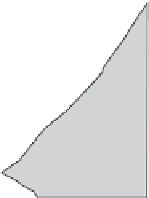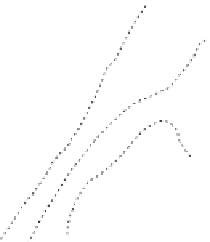Geoscience Reference
In-Depth Information
(a)
(b)
0.4
1
m
s
−
1
1
m s
−
1
1.0
52
°N
5 km
5 km
2.0
Rhine
Rhine
4°E
4°E
the change in tidal ellipse structure between (a) a vertically-mixed situation at spring tides, and
(b) a stratified period at neap tides. In (b) the dotted contour lines show stratification as the
salinity difference
D
S between 10m and 1m depth.
indicate the positions of the radar
antennae. With permission from Elsevier.
rotating in a clockwise direction. At the same time, current meter measurements
reveal that the ellipses in the bottom layer acquire an anticlockwise form so that top
and bottom layers rotate in opposite directions.
It is this vertical contrast in ellipticity which is responsible for the strong cross-
shore shear which acts on the cross-shore density gradient to induce the M
2
cycle of
Fig. 9.12
. At time t
¼
0, it is low water when, in a Kelvin wave, there is peak reverse
flow, i.e. the current is directed to the south-west, there is no cross-shore flow and the
water column is assumed to be mixed. Quarter of a tidal period later (t
T/4), the
alongshore flow is zero, but there is now a pronounced two-layer flow in the cross-
shore direction due to the difference in ellipticity between the surface and bottom
layers. This cross-shore shear flow acts on the density gradient to induce stratification
by moving lighter water near the coast over heavier water further offshore. Max-
imum stratification occurs at high water (t
¼
T/2) when the alongshore flow is
maximal to the north-east and the cross-shore flow is zero. After the next quarter
cycle (t
¼
T/4 and
straining removes the stratification so that complete vertical homogeneity is restored
after a full cycle (t
¼
3T/4), the cross-shore flow is now the reverse of that at t
¼
T).
Figure 9.12
also indicates that the cross-shore straining will lead to upwelling at
the coast in the first half of the tidal cycle and downwelling in the second
half. The occurrence of upwelling has been noted by the appearance of a band
of cold water near the coast detected in I-R imagery of the region by de Boer
et al.,
2009
.
¼




































































































































Search WWH ::

Custom Search